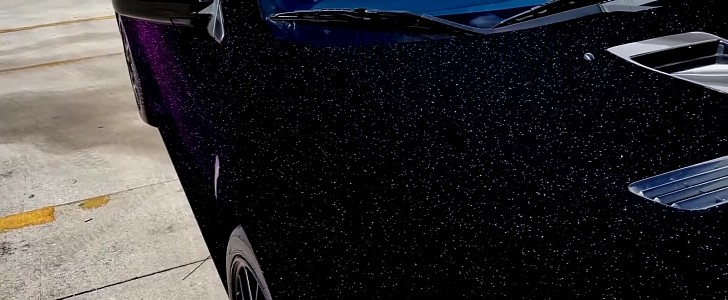Musou Black, a water-based acrylic described as the world's blackest paint, is said to absorb 99.4% of light in the visible range. It sounds amazing, right? Until this month, the most interesting thing that had been done with it was painting half an apple.
That all changed when Fonzie from DipYourCar decided to make the blackest car in the world... unless you count any other car finished in Musou Black. It took several coats and about two gallons of the stuff to get a whole Mitsubishi Evo covered up, but the effect was worth it.
Without a single light reflection in sight, the Japanese sports sedan looked like an aberration, a black hole standing right there on four wheels. It resembled one of those fake Photoshop photos of "murdered out" cars you might stumble upon on Pinterest, but we assure you that it's real.
Taking something like that to the next level isn't easy, but this week, DYC decided to stick to the galactic theme and cover the black hole in stars. After numerous trials, the dipper decided to suspend the HyperShift pearl finish in thinner. This would evaporate and leave only the particles resting on top of the slightly porous Musou finish.
The result is nothing short of breathtaking, previously only possible through CGI. But it won't last. The HyperShift particles are probably not going to resist power-washing, while Musou Black is not designed for automotive use. Putting a protective coat on top would ruin its light-absorbing properties.
We can't see this catching on. Sure, you can do it for a show car. But we did a little digging and found the Japanese paint costs 18,000 yen per liter, which implies the Evo is covered in $1,400 worth of black, plus the black dip underneath and the pear effect.
Without a single light reflection in sight, the Japanese sports sedan looked like an aberration, a black hole standing right there on four wheels. It resembled one of those fake Photoshop photos of "murdered out" cars you might stumble upon on Pinterest, but we assure you that it's real.
Taking something like that to the next level isn't easy, but this week, DYC decided to stick to the galactic theme and cover the black hole in stars. After numerous trials, the dipper decided to suspend the HyperShift pearl finish in thinner. This would evaporate and leave only the particles resting on top of the slightly porous Musou finish.
The result is nothing short of breathtaking, previously only possible through CGI. But it won't last. The HyperShift particles are probably not going to resist power-washing, while Musou Black is not designed for automotive use. Putting a protective coat on top would ruin its light-absorbing properties.
We can't see this catching on. Sure, you can do it for a show car. But we did a little digging and found the Japanese paint costs 18,000 yen per liter, which implies the Evo is covered in $1,400 worth of black, plus the black dip underneath and the pear effect.








